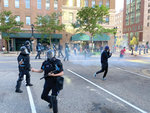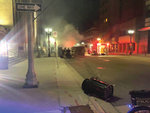




The cleanup was already underway by dawn Monday. Volunteers began to undo the physical damage that swept through downtown Lansing in a chaotic miasma of tear gas, frightened cries and broken windows the night before.
Piecing together the shards of civil society broken in the wake of the murder of George Floyd by police, and the ensuing unrest continuing to sweep dozens of cities across the nation, is another matter.
The chaos in Lansing stopped short of the destruction seen in other cities, but the sequence of events raised serious questions about police tactics used in Lansing and across the country in response to protesters, especially the use of tear gas and the crowding of protesters into enclosed spaces.
The day began with a peaceful march through downtown Lansing, protesting the police killing of George Floyd in Minneapolis. The march kicked off from the Capitol soon after 11 a.m. Sunday and finished about 1:30 p.m. without incident.
Soon afterward, another march moved east toward MSU.
The march arrived at East Lansing City Hall, where a police cruiser parked at the Police parking lot was damaged.
When police confronted protesters on Park Lane, the march moved toward the Target store on Grand River Avenue. While some people appeared ready to break into the store, protesters formed a line to prevent them, according to an eyewitness. The protesters headed west along Michigan Avenue toward downtown Lansing.
On the way from East Lansing to the Capitol, heads whipped around at the sound of a honking horn. Social media videos and other firsthand accounts showed a white woman driving recklessly through the march toward downtown Lansing, just missing several people who were otherwise peacefully walking back from East Lansing on Michigan Avenue. The driver kept on going west, toward the Capitol.
LPD officials said a group of demonstrators attempted to assault the woman on the 100 block of South Washington Square. Michigan State Police troopers circled in and escorted her away, but were overrun by people throwing bottles and rocks, officials reported.
An LPD spokesman did not respond to inquiries about whether the woman was arrested. The woman’s car was overturned and its windows were smashed before it was set ablaze in the street.
Many protesters tried to de-escalate the situation, while others cheered on those who were setting fire to the car. Whether the driver was malicious, confused, panicked or in some other state of mind is unclear, but the scene brought forth horrific memories of August 2017, when a white supremacist rammed into a group of peaceful protesters in Charlottesville, North Carolina.
Meanwhile, the Lansing protest coalesced around the roundabout where Washington Square intersects Michigan Avenue. When marchers arrived from East Lansing, barricades were in place at Ottawa Street and Capitol Avenue. Some protesters headed for the Capitol steps.
At least 15 separate squads of regional cops, including officers from the Michigan State Police, Michigan National Guard, Lansing Police Department and MSU Police Department, were scattered across downtown Lansing.
The burning car was a turning point in the slowly gathering night. Bicycle police gave way to riot clad officers.
Alarmed protesters who wanted to leave the scene reported that they were hemmed in, whether by barricades, lines of officers or — a short time later — clouds of tear gas.
“Our choice on whether to stay or not was essentially made for us,” an eyewitness said.
About 8:15, tear gas canisters began to fly in order to move protesters away from the burning car, lest more fires start, Mayor Andy Schor told City Pulse. Protesters fired back by flinging bottles and other projectiles at police lines.
After that, police announced repeatedly that the mayor had imposed an immediate curfew and that anyone on the street was subject to arrest. But the police did not warn the crowd that more tear gas was coming. Then the police fired a half-dozen canisters and the crowd fled.
Three reporters at City Pulse and at least one reporter from both the Lansing State Journal and WILX were caught in the peppery mist along with dozens of nonviolent bystanders. Among them was Lansing City Councilman Brandon Betz, who said that he was a participant in the protest.
“The use of tear gas was extremely excessive and completely uncalled for,” Betz said. “Especially because it was aimed at peaceful protesters and not people who were agitating the situation.”
People joined hands to escape the clouds of tear gas, helping each other by pouring bottles of water on the faces of those who were temporarily overcome by the fumes.
“They should’ve arrested a few people,” Betz said. “Instead, they tear gassed an entire crowd of citizens.”
According to an eyewitness, a group of middle-school girls ran down an alley next to the Romney Building, clinging to each other as voices were heard calling out to them: “Oh, sweeties! Go, be safe!”
Betz was among those handing out bottles of antacid water to help those who were gassed. He said he saw a 6-year-old child and three senior citizens caught up in the tightening cordon, none of whom could run fast enough to get out of the way as they were cornered downtown.
Christiana Ford, a black WILX reporter, was live on Facebook when the tear gas arrived. At one point, it didn’t appear that she could leave the scene and comply with orders without walking through a cloud of tear gas. The video cuts off as she coughs from the gas on the sidewalk.
Vandals went on to smash windows at a dozen or so downtown businesses as it turned dark. At least one dumpster fire burned in an alley. Police also took reports of some violent fighting among protesters. Lansing Mayor Andy Schor enacted a retroactive 9 p.m. curfew at 9:15 p.m. The streets were mostly quiet by 11 p.m.
Officials told The Detroit News the property damage would amount to more than $10,000. All told, Lansing Police officers made eight arrests that day and have requested a series of criminal charges against the suspects, including arson, damage to property, vagrancy and resisting arrest. The Michigan State Police arrested four more, authorities said Tuesday.
Monday morning’s cleanup crew found broken windows at the Romney Building, at Michigan and Capitol Avenue, where the governor and her staff work. Windows were also broken at Comerica, Linn & Owens Jewelers, the Knapp’s building, Sultan’s Express, Firehouse Subs, MLive, the Downtown YMCA and AT&T. Graffiti was peppered across windows and walls across the city. (See pages 16-17).
The Boji Tower, where crowds were pushed west off Washington, was among the last buildings to be damaged Sunday night. Vandals had knocked out most of the ground floor windows before police could arrive.
The damage to the increasingly tenuous trust between law enforcement and citizens, especially African-American ones, is not so easily calculated.
Schor applauded officers for a job well done, but he said the recent response — as with all major police enforcement events — will be reviewed to see what could be better handled in the future.
“There was violence going on and the police needed to disperse people,” Schor said. “You had people burning dumpsters and burning cars and it was really a dangerous situation. It was used to disperse people and it worked. People left the area, and that’s the idea, to get them to leave.”
With the sting of tear gas fresh in his memory, Betz aired his displeasure in a Facebook post Tuesday morning. “The police could have handled this any other way,” he wrote. “Instead, they turned to violence immediately. Tear gassing peaceful protesters is a completely unacceptable response to a small amount of vandalism.”
East Lansing Mayor Ruth Beier, too, took a conciliatory tack, saying that “only a few” people were out to do damage.
“Our goal was to let everybody protest and not interfere, even if there was some damage,” she said. “We just don’t need to police people so much. Unless someone is posing a danger to themselves or others, we need to leave them alone. Give a ticket if you have to, but walk away.”
(This story was written by Lawrence Cosentino based on reporting by Skyler Ashley, Cole Tunningley and Berl Schwartz.)
Support City Pulse - Donate Today!
Other items that may interest you

Comments
No comments on this item Please log in to comment by clicking here